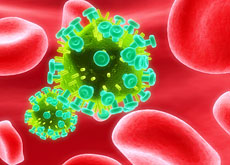Deadly fox disease lurks in gardens

Switzerland's foxes have been increasing in number and moving into towns and cities as rabies loses its bite.
But while foxes are thriving, so are the tapeworms they carry which are causing more and more cases of liver disease in humans.
It’s early morning on a main street somewhere in Switzerland. A noise to your right – a rustling of leaves – and a fox is standing there, watching carefully.
Or you look out your window one night after hearing some high-pitched yapping to see two foxes fighting.
Neither situation is uncommon. In many European countries fox populations have been growing for the past 15 years thanks to vaccination campaigns against rabies.
At the same time, the animals have been making themselves at home in urban areas. According to the Federal Veterinary Office, more than ten foxes can live within one square kilometre in residential zones.
But their arrival has also brought another problem into Swiss towns and villages: human alveolar echinococcus (AE).
“It takes about ten to 15 years for the disease to really manifest itself after infection, so the rise in the number of cases can be correlated with the increase in fox numbers,” said Andrew Hemphill, a parasitologist at Bern University.
AE, a rare but severe disease that resembles liver cancer, is caused by absorbing the larvae of fox tapeworm, a widespread intestinal parasite among foxes. The larvae usually develop in the liver and slowly destroy it.
“It is a public health problem because if you can’t eliminate by surgery, it means patients have to be treated every day for up to 15 years with high doses of drugs,” said Peter Deplazes, a parasite specialist at Zurich University.
If it goes undiscovered, it can progress beyond the liver and attack other organs, eventually spreading to all parts of the body. AE is also hard to detect because of its slow development and does not present typical symptoms, leading to late diagnosis in many cases.
Transmission
Different theories exist for how the disease is transmitted. One is that eating forest fruit contaminated by foxes passes it on, but the most popular hypothesis is that domestic animals are the vectors.
“Cats and especially dogs act as an infection source,” Hemphill told swissinfo. “Dogs eat everything they can find including mice that might be infected.”
Treatment involves surgery to remove infected parts of the liver, which often resembles a holey Swiss cheese or a sponge, followed by chemotherapy for several years.
“Improved treatments have helped expand people’s life expectancy considerably, but new drugs are not really being developed by pharmaceutical companies,” he added.
“They are not interested because it is basically an orphan disease, meaning there is no money to be made.”
With no silver bullet available, researchers are restricted to testing chemical compounds, hoping to find a potential cure.
“A good approach is probably to look at compounds that can deal with a broad spectrum of parasites, such as those being developed to tackle malaria or tropical diseases,” Hemphill said.
He added that if drug companies were prepared to put up the money, it would be much easier to find better compounds. “It’s essentially a financial question.”
No guarantees
Anti-cancer drugs represent another possibility, since AE parasites have similarities with cancerous tumours. However, what works in the test tube doesn’t always work in animals.
Fortunately only a few patients do not respond to available drugs.
Also, if the liver cannot be saved, transplantation can be carried out – although there are no guarantees it will be successful: the parasite can lurk in the bloodstream or elsewhere in the body and attack the organ again.
swissinfo, Scott Capper
AE is widely distributed in the Northern Hemisphere. The disease-endemic area stretches from North America through Europe to central and eastern Asia.
Parasite eggs are shed into the environment by hosts that harbour the adult parasite in their intestines.
Humans and other animals acquire the infection by ingesting eggs in contaminated food or water or by having close physical contact with infected foxes, dogs or host faeces.
In Europe, the tapeworm exists predominantly in red foxes as the definitive hosts and several vole species.
In the United States and Canada, the coyote has also been shown to be a suitable host for this parasite.
In some areas, domestic dogs are often definitive hosts too. In regions such as Alaska, China and Europe, they can play an additional or even dominant role as an infection source for humans.

In compliance with the JTI standards
More: SWI swissinfo.ch certified by the Journalism Trust Initiative



You can find an overview of ongoing debates with our journalists here. Please join us!
If you want to start a conversation about a topic raised in this article or want to report factual errors, email us at english@swissinfo.ch.